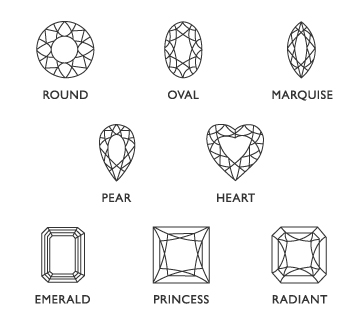A Crash Course in Choosing Diamonds!
 Understanding diamonds can be a bit of a minefield! Last month we discussed engagement ring styles and it’s important that the diamond you choose fits with your selected style of ring but also your budget. Generally the diamond will be the most expensive part of an engagement ring so it’s important you get the right one.
Understanding diamonds can be a bit of a minefield! Last month we discussed engagement ring styles and it’s important that the diamond you choose fits with your selected style of ring but also your budget. Generally the diamond will be the most expensive part of an engagement ring so it’s important you get the right one.The 4 C’s are a common way of helping you understand the different characteristics of diamonds, these are Cut, Colour, Carat and Clarity.
 Cut
Cut
Cut is often confused with the shape of the diamond, for example brilliant cut (round stone) or princess cut (square stone). The other shapes available include oval, marquise, pear, heart, emerald and radiant/cushion. The most popular cut is brilliant. Cut is actually a measure of how diamonds facets interact with light. Cut is the only C that is influenced by the human hand. The rest are created naturally as diamonds form in the earth.
Colour
The colour of a diamond is measured on a scale from D to Z, D is colourless and this allows more light to pass through, giving the diamond more sparkle. As the grading progresses through the alphabet to Z, the diamonds take on a yellowish/brownish tone. Anything up to colour H is considered white, with a hint of yellow appearing in diamonds graded from I onwards.
Carat
Carat is the weight of a diamond and one carat is the equivalent of 200 milligrams. It can also be divided into 100 "points", a 0.75 carat diamond is the same as a 75-points or a 3/4 carat diamond.
Clarity
Clarity is the visual appearance of internal characteristics of a diamond called inclusions and surface defects called blemishes. The GIA diamond grading scale is divided into six categories, starting with FL (Flawless) and moving through to Internally Flawless category (IF), Very, Very Slightly Included category (VVS), Very Slightly Included category (VS) Slightly Included category (SI), Included category (I). The most popular gradings are VS and SI. From SI2 upwards, inclusions should only be visible through 10x magnification.
Each one of these characteristics will affect the price you pay for a diamond.